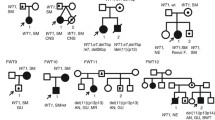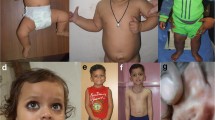Abstract
Purpose
11p13 and 11p15 loss of heterozygosity (LOH) in Wilms tumor (WT), the commonest molecular pathogenetic event in WT, shows variation in different parts of the world. The present study looked for the presence of 11p13 and 11p15 LOH as well as nephrogenic rests in WT occurring in India.
Method
Twenty-two cases of WT were subjected to thorough pathological examination for presence of nephrogenic rests. Fresh frozen tissue was evaluated for LOH at 11p13 and 11p15, using PCR for microsatellite markers.
Results
Among twenty-two consecutive cases of WT, 20 were unilateral and 2 were bilateral. 6/22 showed LOH at 11p13 (27.7 %) and 1/22 showed LOH at 11p15 (4.54 %). 2/22 cases showed presence of nephrogenic rests. One of the cases with LOH at 11p13 had intralobar nephrogenic rest in the adjacent kidney. One specimen had perilobar nephrogenic rest in the adjacent kidney but did not show LOH for either 11p13 or 11p15 in the tumor.
Conclusion
LOH at 11p13 is seen in 27.27 % of WT in India, which is similar to reports in the English language literature. LOH at 11p15 was seen in 4.54 % of WT, which is lower than that reported from Western subjects.
Similar content being viewed by others
References
Stiller CA, Parkin DM (1990) International variations in the incidence of childhood renal tumors. Br J Cancer 62:1026–1030
Breslow N, Olshan A, Beckwith JB, Moksness J, Feigl P, Green D (1994) Ethnic variations in the incidence, diagnosis, prognosis, and follow up of children with Wilms tumor. J Natl Cancer Inst 86:49–51
Stiller CA, McKinney PA, Bunch KJ, Bailey CC, Lewis IJ (1991) Childhood cancer and ethnic group in Britain: a United Kingdom Children’s Cancer Study Group (UKCCSG) Study. Br J Cancer 54:543–548
Beckwith JB, Kiviat NB, Bonadio JF (1990) Nephrogenic rests, nephroblastomatosis, and the pathogenesis of Wilms tumor. Pediatr Pathol 10:1–36
Charles AK, Brown KW, Berry PJ (1998) Microdissecting the genetic events in nephrogenic rests and Wilms’ tumor development. Am J Pathol 153:991–1000
Schumacher V, Schuhen S, Sonner S, Weirich A, Leuschner I, Harms D, Licht J, Roberts S, Royer-Pokora B (2003) Two molecular subgroups of Wilms’ tumors with or without WT1 mutations. Clin Cancer Res 9:2005–2014
Fukuzawa R, Breslow NE, Morison IM, Dwyer P, Kusafuka T, Kobayashi Y, Becroft DM, Beckwith JB, Perlman EJ, Reeve AE (2004) Epigenetic differences between Wilms’ tumors in white and east-Asian children. Lancet 363:446–451
Mishra K, Mathur M, Logani KB, Kakkar N, Krishna A (1998) Precursor lesions of Wilms’ tumor in Indian children. A multiinstitutional study. Cancer 83:2228–2232
Beckwith JB (1998) Nephrogenic rests and the pathogenesis of Wilms tumor: development and clinical considerations. Am J Med Genet 79:268–273
Beckwith JB (1993) Precursor lesions of Wilms tumor and biological implications. Med Pediar Oncol 21:158–168
Beckwith JB (1998) Nephrogenic rests and the pathogenesis of Wilms tumor: development and clinical considerations. Am J Med Genet 79:268–273
Van Heyningen V, Hastie ND (1992) Wilms’ tumour: reconciling genetics and biology. Trends Genet 8:16–21
Grundy PE, Telzerow PE, Breslow N, Moksness J, Huff V, Paterson MC (1994) Loss of heterozygosity for chromosomes 16q and 1p in Wilms’ tumors predicts an adverse outcome. Cancer Res 1994(54):2331–2333
Grundy P, Telzerow P, Moksness J, Breslow NE (1996) Clinicopathologic correlates of loss of heterozygosity in Wilms’ tumor: a preliminary analysis. Med Pediatr Oncol 27:429–433
Grundy PE, Breslow NE, Li S, Perlman E, Beckwith JB, Ritchey ML, Shamberger RC, Haase GM, D’ Angio GJ, Donaldson M, Coppes MJ, Mologolowkin M, Shearer P, Thomas PRM, Macklis R, Tomlinson G, Huff V, Green DM (2005) Loss of heterozygosity for chromosomes 1p and 16q is an adverse prognostic factor in favorable histology Wilms’ tumor. A report from the National Wilms’ Tumor Study Group. J Clin Oncol 23:7312–7321
Agarwal S, Iyer VK, Agarwala S, Mathur SR, Aron M, Datta Gupta S, Verma K (2011) Apoptotic protein expression in favorable-histology Wilms tumor correlates with tumor recurrence. Pediatr Surg Int 27:303–308
Nayak A, Iyer VK, Agarwala S (2011) The cytomorphologic spectrum of Wilms tumour on fine needle aspiration: a single institutional experience of 110 cases. Cytopathology 22:50–59
Ravenel JD, Broman KW, Perlman EJ, Niemitz EL, Jayawardena TM, Bell DW, Haber DA, Uejima H, Feinberg AP (2001) Loss of imprinting of insulin-like growth factor-II(IGF2) gene in distinguishing specific biologic subtypes of Wilms’ tumor. J Natl Cancer Inst 93:1698–1703
Schumacher V, Schneider S, Figge A, Wildhardt G, Harms D, Schmidt D, Weirich A, Ludwig R, Royer-Pokora B (1997) Correlation of germline mutations and two-hit inactivation of the WT1 gene with Wilms’ tumors of stromal-predominant histology. Proc Natl Acad Sci USA 94:3972–3977
Koesters R, Ridder R, Kopp-Schneider A, Betts D, Adams V, Niggli F, Briner J, von Knebel Doeberitz M (1999) Mutational activation of the b-catenin protooncogene is a common event in the development of Wilms tumors. Cancer Res 59:3880–3882
Koesters R, Niggli F, von Knebel Doeberitz M, Stallmach T (2003) Nuclear accumulation of beta-catenin protein in Wilms’ tumours. J Pathol 199:68–76
Maiti S, Alam R, Amos CI, Huff V (2000) Frequent association of beta-catenin and WT1 mutations in Wilms’ tumors. Cancer Res 60:6288–6292
Author information
Authors and Affiliations
Corresponding author
Rights and permissions
About this article
Cite this article
Sigamani, E., Wari, M.N., Iyer, V.K. et al. Loss of heterozygosity at 11p13 and 11p15 in Wilms tumor: a study of 22 cases from India. Pediatr Surg Int 29, 223–227 (2013). https://doi.org/10.1007/s00383-012-3254-8
Accepted:
Published:
Issue Date:
DOI: https://doi.org/10.1007/s00383-012-3254-8




